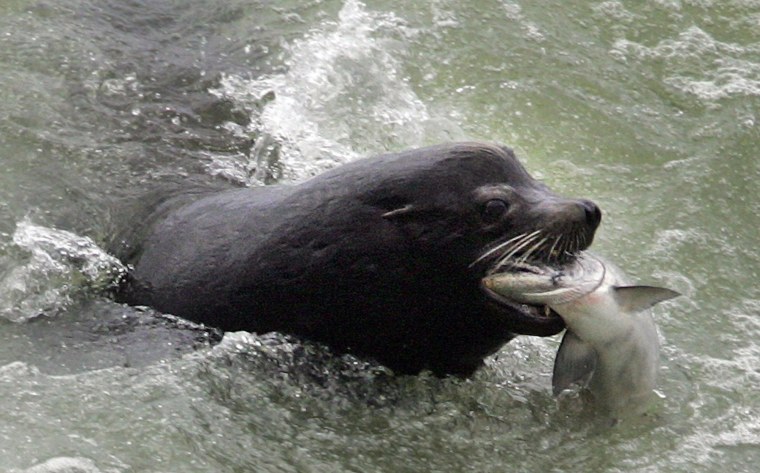Wildlife officials have tried everything to keep sea lions from eating endangered salmon, including dropping bombs that explode under water and firing rubber bullets and bean bags from shotguns and boats. Now they are resorting to issuing death sentences to the most chronic offenders.
A California sea lion last week became the first salmon predator to be euthanized this year under a program that has been denounced by those who say there are far greater dangers to salmon — including the series of hydroelectric dams on the Columbia.
This is the second year of the program, which is administered by wildlife officials in Oregon and Washington and the National Oceanic and Atmospheric Administration.
Last year, 11 sea lions were euthanized. Another four were transferred to zoos or aquariums.
The sea lions represent a massive headache each year as chinook salmon begin arriving at the Bonneville Dam east of Portland, congregating in large numbers as they return from the ocean. Sea lions have become keenly aware that the dam is a great spot to feast on salmon, easy pickings as they wait to go up the dam's fish ladders.
"They learn. They come up here and know it's a good place to eat, and sooner or later the salmon are going to arrive," said Robert Stansell, a fisheries biologist with the U.S. Army Corps of Engineers.
Repeat offenders
Officials are tracking 63 additional sea lions listed as repeat offenders. They are identified by scars or by numbers that were branded on them by researchers.
"To get on that list, we have to have observed them as distinct individuals," said Jessica Sall, spokeswoman for the U.S. Fish and Wildlife Service. "They are not responding to hazing, and they're eating chinook salmon."
Sea lions have gobbled salmon forever. But their numbers have soared in recent years, as has the number of those cruising upriver to dine on salmon at Bonneville Dam. Frustrations peaked, especially among fishermen who have watched sea lions snatch salmon right out of their gill nets.
The Bonneville crowd of hefty mammals — they can reach more than 600 pounds and eight feet in length — have become the enemy of commercial and sport fisherman, who are allowed to catch and keep hatchery-raised fish, and a concern for conservationists trying to restore migratory runs, since sea lions don't distinguish between hatchery and wild fish.
At least three of the upper Columbia River spring salmon runs that pass through the dam are listed as threatened under the Endangered Species Act, most significantly the spring chinook salmon run.
The sea lions' growing numbers forced state, federal and tribal agencies to intensify efforts to protect the region's multibillion-dollar salmon recovery program.
The sea lions are protected by a 1972 federal law, but an amendment leaves open the possibility that some can be captured or killed if the states request it. Oregon and Washington did in 2006 with the support of Indian tribes and sport and commercial fishing groups.
Two years ago, the National Marine Fisheries Service authorized Oregon and Washington officials to first attempt to catch the sea lions that arrive at the base of Bonneville Dam and hold them 48 hours to see whether an aquarium, zoo or similar facility will take them.
Otherwise, they could be euthanized, along with those that avoid trapping. Only California sea lions can be destroyed. Stellar sea lions cannot be killed because they are protected under the Endangered Species Act.
Supporters say the program works. The numbers of sea lions at the dam have dropped, although the 4,489 salmon they ate last year was the highest since tracking began in 2002.
Fishing, hydroelectric dams pose risk
Critics, led by the Humane Society of the United States, say that a far greater danger to salmon are hydroelectric dams on the Columbia, which are an obstacle to salmon both as they head out to sea and when they return from the ocean to spawn.
The Humane Society also says fishermen catch three times as many salmon as sea lions eat.
The Columbia River Inter-Tribal Fish Commission this year has begun tracking the sea lions' movements with acoustic transmitters and cameras placed along the river. Instead of just reacting to the sea lions, the data might help authorities plan a more successful campaign, a fisheries scientist says.
"All of the counts that you hear, all of the impact on salmon, is based on what they can see from the dam," said Doug Hatch, of the inter-tribal commission. "That doesn't account for the whole 150 river miles below the dam."
The frustration comes as experts predict the largest spring chinook run since 1938. Thanks to good ocean conditions for young salmon, an expected 470,000 fish will head up the Columbia River, compared to 169,300 in 2009.
The primary weapon against the sea lions still remains hazing, but even that has limitations.
"The problem is, as soon as the boats go around the corner, they're right back," Stansell said. "Some of the animals that have been there a long time don't even move when they get hit in the back with a rubber bullet. They just keep eating their fish."
